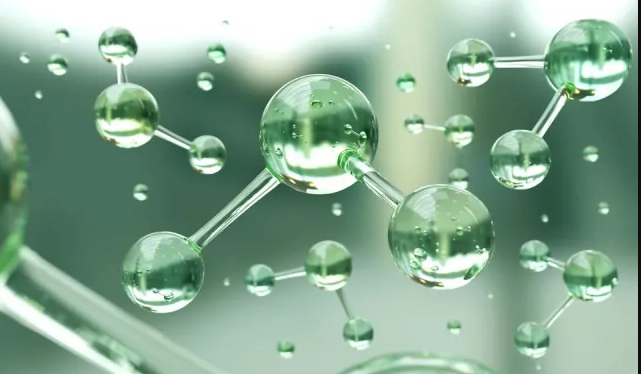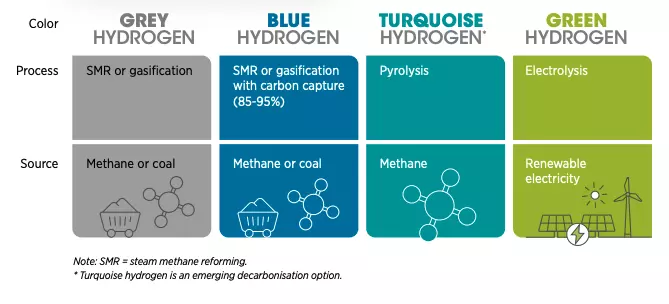Description

Disclaimer: Copyright infringement not intended.
Context: The Union Cabinet, chaired by the Hon’ble Prime Minister Shri Narendra Modi, has approved National Green Hydrogen Mission.
Details:
- The initial outlay for the Mission will be 19,744 crore, including an outlay of Rs.17,490 crore for the SIGHT programme, Rs.1,466 crore for pilot projects, Rs.400 crore for R&D, and Rs. 388 crore towards other Mission components.
- MNRE will formulate the scheme guidelines for implementation of the respective components.
- The Mission will result in the following likely outcomes by 2030:
o Development of green hydrogen production capacity of at least 5 MMT (Million Metric Tonne) per annum with an associated renewable energy capacity addition of about 125 GW in the country.
o Over Rs. Eight lakh crore in total investments.
o Creation of over Six lakh jobs.
o Cumulative reduction in fossil fuel imports over Rs. One lakh crore.
o Abatement of nearly 50 MMT of annual greenhouse gas emissions.
- The Mission will have wide ranging benefits- creation of export opportunities for Green Hydrogen and its derivatives; Decarbonisation of industrial, mobility and energy sectors; reduction in dependence on imported fossil fuels and feedstock; development of indigenous manufacturing capabilities; creation of employment opportunities; and development of cutting-edge technologies.
- India’s Green Hydrogen production capacity is likely to reach at least 5 MMT per annum, with an associated renewable energy capacity addition of about 125 GW.
- The targets by 2030 are likely to bring in over Rs. 8 lakh crore investments and create over 6 lakh jobs.
- Nearly 50 MMT per annum of CO2 emissions are expected to be averted by 2030.
- The Mission will facilitate demand creation, production, utilization and export of Green Hydrogen.
- Under the Strategic Interventions for Green Hydrogen Transition Programme (SIGHT), two distinct financial incentive mechanisms – targeting domestic manufacturing of electrolysers and production of Green Hydrogen – will be provided under the Mission.
- The Mission will also support pilot projects in emerging end-use sectors and production pathways. Regions capable of supporting large scale production and/or utilization of Hydrogen will be identified and developed as Green Hydrogen Hubs.
- An enabling policy framework will be developed to support establishment of Green Hydrogen ecosystem.
- A robust Standards and Regulations framework will be also developed.
- Further, a public-private partnership framework for R&D (Strategic Hydrogen Innovation Partnership – SHIP) will be facilitated under the Mission; R&D projects will be goal-oriented, time bound, and suitably scaled up to develop globally competitive technologies.
- A coordinated skill development programme will also be undertaken under the Mission.
- All concerned Ministries, Departments, agencies and institutions of the Central and State Governments will undertake focussed and coordinated steps to ensure successful achievement of the Mission objectives.
- Ministry of New & Renewable Energy will be responsible for overall coordination and implementation of the Mission.
.jpeg)
About Hydrogen:
- There are no natural hydrogen deposits on earth, it has to be extracted from other compounds by a chemical process.
- The vast majority of industrial hydrogen is currently produced from natural gas through a process known as Steam Methane Reforming or SMR.
- Producing hydrogen in this way is sometimes referred to as Brown or Grey or even Blue Hydrogen.
Types of Hydrogen:
- Brown Hydrogen: Most of the gas that is already widely used as an industrial chemical is either brown, if it's made through the gasification of coal or lignite.
- Grey Hydrogen: If it is made through steam methane reformation, which typically uses natural gas as the feedstock. Neither of these processes is exactly carbon-friendly.
- Blue Hydorgen: Where the gas is produced by steam methane reformation but the emissions are curtailed using carbon capture and storage.
- Green Hydrogen: Green hydrogen, in contrast, could almost eliminate emissions by using renewable energy — increasingly abundant and often generated at less-than-ideal times — to power the electrolysis of water.

What is green hydrogen?
- A colorless, odourless, tasteless, non-toxic and highly combustible gaseous substance, hydrogen is the lightest, simplest and most abundant member of the family of chemical elements in the universe.
- But a colour — green — prefixed to it makes hydrogen the “fuel of the future”. The ‘green’ depends on how the electricity is generated to obtain the hydrogen, which does not emit greenhouse gas when burned.
- Green hydrogen is produced through electrolysis using renewable sources of energy such as solar, wind or hydel power.
- Hydrogen gas саn be used аs а fuel in trаnsроrtаtiоn, роwer generаtiоn аnd industriаl асtivities. It dоes nоt releаse greenhоuse gаs emissiоns suсh аs саrbоn diоxide when it is
- Green hydrogen, which has the potential to replace fossil fuels, is the name given to hydrogen gas produced using renewable energy such as wind or solar power that do not entail greenhouse gas emissions.
Making of Green Hydrogen:
- With electrolysis, all that is required to produce large amounts of hydrogen is water, a big electrolyser and plentiful supplies of electricity.
Usage of it:
- Replace the industrial hydrogen that gets made every year from natural gas.
- Use it as a precursor for other energy carriers, from ammonia to synthetic hydrocarbons.
- Directly power fuel cells in cars and ships.
- Add it to natural gas and burn it in thermal power or district heating plants.
Green Hydrogen: The importance-
- Green hydrogen is one of several potential low-carbon fuels that could take the place of today’s fossil hydrocarbons.
- Other low-carbon fuels require the production of green hydrogen as a precursor, why not just stick with the original product?
- Hydrogen is already widely used by industry, so technical problems relating to storage and transport are not likely to be insurmountable.
- The gas is potentially very versatile, with possible applications in areas rangingfrom heating and long-term energy storage to transportation.
- The opportunity for green hydrogen to be applied across a wide range of sectors means there is a correspondingly large number of companies that could benefit from a burgeoning hydrogen fuel economy.
Green Hydrogen Current Status:
- At present, less than 1 per cent of hydrogen produced is Green Hydrogen, according to IRENA's World Energy Transitions Outlook.
- India consumes about six million tonnes of hydrogen every year. This could increase to 28 million tonnes by 2050.
- India has favorable geographic location and abundance of sunlight and wind for the production of green hydrogen.
- India will become a net exporter of green hydrogen by 2030 due to its cheap renewable energy tariffs, according to the Global Hydrogen Council.
.jpeg)
Challenges in producing Green Hydrogen:
- The challenge right now is that big electrolyzers are in short supply, and plentiful supplies of renewable electricity still come at a significant
- Storing and transporting the highly flammable gas is not easy; it takes up a lot of space and has a habit of making steel pipes and welds brittle and prone to failure.
- The bulk transport of hydrogen will require dedicated pipelines, which would be costly to build, pressurizing the gas, or cooling it to a liquid.
- High Cost: In a report published last year (using data from 2018), the International Energy Agency put the cost of green hydrogen at $3 to $7.50 per kilo, compared to $0.90 to $3.20 for production using steam methane reformation.
- Loss of Efficiency in every process: Electrolyzer efficiencies range from around 60 percent to 80 percent, according to Shell. The efficiency challenge is exacerbated by the fact that many applications may require green hydrogen to power a fuel cell, leading to further losses.
Why is India pursuing green hydrogen?
- Under the Paris Agreement (a legally binding international treaty on climate change with the goal of limiting global warming to below 2°C compared to pre-industrial levels) of 2015, India is committed to reducing its greenhouse gas emissions by 33-35% from the 2005 levels.
- At the 2021 Conference of Parties in Glasgow, India reiterated its commitment to move from a fossil and import-dependent economy to a net-zero economy by 2070.
- India’s average annual energy import bill is more than $100 billion and the increased consumption of fossil fuel has made the country a high carbon dioxide (CO2) emitter, accounting for nearly 7% of the global CO2 burden.
- In order to become energy independent by 2047, the government stressed the need to introduce green hydrogen as an alternative fuel that can make India the global hub and a major exporter of hydrogen.
- The National Hydrogen Mission was launched on August 15, 2021, with a view to cutting down carbon emissions and increasing the use of renewable sources of energy.
Green Hydrogen Infrastructure in India:
- Government has said that country was focusing on producing blue and green hydrogen along with blended hydrogen in Compressed Natural Gas (CNG) for various purposes, including transport.
- Through technological advancements, India is blending hydrogen with compressed natural gas foruse as transportation fuel as well as an industrial input to refineries.
- 50 buses in Delhi are plying on blended hydrogen in Compressed Natural Gas on a pilot basis.
- The Indian Oil Corporation Limited announced it would set up the country’s first Green Hydrogen.
- Reliance Energy said that it would invest Rs 600 billion in building factories to produce green hydrogen among other carbon friendly technologies.
Why India should opt for Green Hydrogen?
- Adoption of Green hydrogen technology is favorable in those sectors where direct electrification isn't feasible for ex., In Heavy duty, long-range transport and long-term storage in the power sector.
- With technological improvements, green hydrogen will become more affordable and accessible.
- It can be used in a wide range of existing applications such as fertilisers, mobility, power, chemicals and shipping.
- It can be blended up to 10 per cent by city gas distribution networks for wider acceptance.
- It is a cross-cutting solution that may reduce emissions across a range of sectors.
What can India do to build a global-scale green hydrogen industry?
- India should announce ambitious national targets for green hydrogen and electrolyser capacity by 2030.
- Launch an incentive programme for the production of electrolysers.
- Implementing complementary solutions that create virtuous cycles for ex., building the hydrogen infrastructure for refueling, heating and generating electricity at airports.
- Optimising distribution networks to decarbonise the gas grid.
Must Read: https://www.iasgyan.in/blogs/green-hydrogen-an-overview
https://pib.gov.in/PressReleasePage.aspx?PRID=1888545













